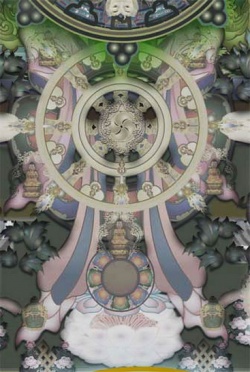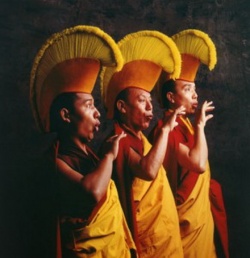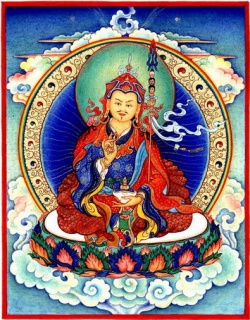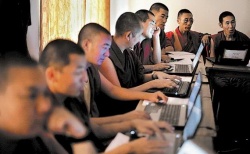Me Agtsom
Mes-ag-tshoms, Me Aktsom, Tride Tsugtsän (Wylie: Khri-lde-gtsug-btsan, Chinese: 墀德祖贊, 尺帶珠丹, 棄隸蹜贊 Pinyin: Chǐdàizhūdān, Qìlìsùzàn) (704–755 CE)[1] was a Tibetan emperor; the son of Tridu Songtsen and his queen mChims-bza' bTsan-ma Thog-thog-steng. He is usually known by his nickname "Mes-ag-tshoms" ('Old Hairy'), which was given to him later in life because he was so hirsute.[2]
His father, Tridu Songtsen, died in 704 in battle in Mywa (probably = the Miao people)[3] territory in Jang (Nanzhao) in modern Yunnan. The Tang Annals state he was on his way to suppress tributary kingdoms on the southern borders of Tibet, including Nepal and parts of India. There was a dispute among his sons but, "after a long time" the people put Qilisuzan (Khri-lde-gtsug-btsan) or Mes-ag-tshoms, aged only seven, on the throne.[4][5]
Reign of Tride Tsuktsän (704–754)
Gyältsugru (Rgyal-gtsug-ru), later to become King Tride Tsuktsän (Khri-lde-gtsug-brtsan), generally known now by his nickname Me Agtsom ("Old Hairy"), was born in 704. Upon the death of Tridu Songtsen, his mother Thrimalö ruled as regent for the infant Gyältsugru.[6] The following year the elder son of Tridu Songtsen, Lha Balpo (Lha Bal-pho) apparently contested the succession of his one-year-old brother, but was "deposed from the throne" at Pong Lag-rang.[6][7]
Thrimalö had arranged for a royal marriage to a Chinese princess. The Princess Jincheng (金成) (Tibetan: Kyimshang Kongjo) arrived in 710, but it is somewhat unclear whether she married the seven-year-old Gyältsugru[8] or the deposed Lha Balpo.[9] Gyältsugru also married a lady from Jang (Nanzhao) and another born in Nanam.[10]
Gyältsugru was officially enthroned with the royal name Tride Tsuktsän in 712,[6] the year that dowager empress Thrimalö died.
The Caliphate and Göktürks became increasingly prominent during 710–720. The Tibetans were allied with both. Tibet and China fought on and off in the late 720s. At first Tibet (with Göktürk allies) had the upper hand, but then they started losing battles. After a rebellion in southern China and a major Tibetan victory in 730, the Tibetans and Göktürks sued for peace.
In 734 the Tibetans married their princess Dronmalön (‘Dron ma lon) to the Göktürk Qaghan. The Chinese allied with the Caliphate to attack the Göktürks. After victory and peace with the Göktürks, the Chinese attacked the Tibetan army. The Tibetans suffered several defeats in the east, despite strength in the west. The Göktürk empire collapsed from internal strife. In 737, the Tibetans launched an attack against the king of Bru-za (Gilgit), who asked for Chinese help, but was ultimately forced to pay homage to Tibet. In 747, the hold of Tibet was loosened by the campaign of general Gao Xianzhi, who tried to re-open the direct communications between Central Asia and Kashmir.
By 750 the Tibetans had lost almost all of their central Asian possessions to the Chinese. In 753, even the kingdom of "Little Balur" (modern Gilgit) was captured by the Chinese. However, after Gao Xianzhi's defeat by the Caliphate and Qarluqs at the Battle of Talas (751), Chinese influence decreased rapidly and Tibetan influence began to increase again. Tibet conquered large sections of northern India during this time.
In 755 Tride Tsuktsän was killed by the ministers Lang and ‘Bal. Then Tagdra Lukong (Stag-sgra Klu-khong) presented evidence to prince Song Detsän (Srong-lde-brtsan) that they were disloyal and causing dissension in the country, and were about to injure him also. Subsequently, Lang and ‘Bal really did revolt. They were killed by the army and their property was confiscated."[11]
Struggle for the throne
It is very unclear, however, from the sources exactly what happened after the death of Tridu Songtsen. According to the Tibetan Annals, "he who would be crowned king" (i.e. Mes-ag-tshoms?) was born in the spring of 704, just a few months before his father died.
Beckwith states that in the winter of 704-705, Lha ("Balpho" or Lha Balpo), one of the sons of Tridu Songtsen, took the throne, but Thrimalö (Khri ma lod), the dowager empress, wife of Mangsong Mangtsen and mother of Tridu Songtsen, "dethroned Lha in favor of the infant Rgyal Gtsug ru, the future Khri gtsug brtsan, popularly known as Mes ag tshoms. Revolts and executions accompanied the virtual coup, but the Annals and Chinese sources have little to report on them. It is interesting to note that Lha apparently was not killed, but only forced into semi-retirement. It was thus, perhaps, the "Retired Emperor" Lha who actually received and married the Chinese princess Chin-ch'eng in 710.[12] In any event, Tibet experienced more internal unrest, and was conspicuously quiet on its borders with China."[13]
Whatever the case, Mes-ag-tshoms was crowned king in 705 CE,[14] although he was not formally enthroned until the death of Khri ma lod in 712.[15]
The Chinese Princess, her support of Buddhism and the Khotanese monks
The Chinese Princess Jincheng Gongzhu (?-739), Zongli, the "real daughter" of the king of Yong, and an adoptive daughter of Emperor Zhongzong of Tang (r. 705-710),[16] was sent to Tibet in 710 where, according to most sources, she married Mes-ag-tshoms, who would have been only six or seven years old at the time.[17] She was known in Tibet as Gyim shang Ong co, or, simply, Kim-sheng or Kong-co, and was a devout Buddhist.
Five Buddhist temples were built at: 'Ching bu nam ra, Kwa chu in Brag dmar, 'Gran bzang, 'Khar brag and sMas gong.[18]
Buddhist monks from Khotan (Li), fleeing the persecutions of an anti-Buddhist king, were given refuge by Kim-sheng about 737. The story of these Khotanese monks is recorded the Li yul lung-btsan-pa or 'Prophecy of the Li Country', a Buddhist history of Khotan which has been preserved as part of the Tibetan Tanjur.
Kim-sheng died during an outbreak of smallpox sometime between 739 and 741. The rise of anti-Buddhist factions in Tibet following the death of the Chinese princess began to blame the epidemic on the support of Buddhism by the king and queen.[19] This forced the monks to flee once again; first to Gandhara, and then to Kosambi in central India where the monks, apparently ended up quarrelling and slaughtering each other. [20]
Mes-ag-tshoms' other wives
Mes-ag-tshoms had two other wives, a noblewoman from the Nanam clan, Mang-mo-rje bZhi-steng, who died in 730,[21] and a princess from 'Jang (Nanzhao) called lCam lHa-spangs.[19]
Political and military activities during his reign
In 717 the Tibetans (according to an 11th-century Chinese history) joined with the Turkic Türgish to attack Kashgar.[22]
In 720 Tibetan troops took the Uighur principality of 'Bug-cor in the Dunhuang oasis.[23]
The Tang Annals report that in 722 the Tibetans attacked Gilgit (Tib. Bru-sha) which implies they had already gained control of Ladakh and Baltistan through which they would have had to pass. Not really, Tibetans could have gone through taglokan region and attacked Gilgit without needing to take Baltistan and Ladakh. Actually, even the paths and trade routes through Shaksgham and through Baltistan are present so ladakh may not even be remotely involved. [24][25]
In 727 the king left to take control of the government of the 'Azha in hand. He then seized the important Chinese fortress of Kva-cu or Guazhou at (Anxi), to the southeast of Dunhuang, which contained supplies for all the Chinese-dominated territories as far as the Western Turks (Dru-gu) to the north and the Tazig (Arabs) to the west, and all this wealth fell into the hands of the Tibetans so that even ordinary Tibetans had fine Chinese silks to dress up in.[21][26] However, the Chinese managed to drive the Tibetans away in 728, after a siege of eighty-days.[27]
In 724, according to a Chinese encyclopedia of 1013, the Chinese princess, Kim-sheng secretly wrote to the ruler of Kashmir asking for asylum, but apparently nothing came of this.[23]
In 730 a peace treaty with China was signed which established the border east of Kokonor at the Chiling Pass in the Red Hills. In 733 Mes-ag-tshoms wrote to the Chinese emperor Xuanzong (r. 712-756) stating that China and Tibet were equally great kingdoms and hoping that peace would endure. In 734 a pillar engraved with the treaty was erected, and although it was apparently torn down soon after, envoys travelled regularly between the Lhasa and Chang'an for the next fifteen years.[28]
In 736 Tibet again attacked Bru-sha (Gilgit), and the ruler came to Tibet to pay homage. later that year the Chinese also attacked Bru-sha, but in 740 the Tibetan princess Khri-ma-lod married the ruler of Bru-sha.
In 738 the 'Nine Loops of the Huang Ho', which had been given to Tibet as part of a dowry, were retaken by the Chinese.
In 740, the Chinese also regained control of the key fortress at Anrong, just north of Chengdu, which the Tibetans had held for over sixty years. In 742 the Chinese also managed to recapture the formidable fortress of Shipu, near the border in the Red Hills.[27]
In 747 the Chinese, under command of the Korean general, Gao Xianzhi, fought the Tibetans and forced them to leave the region.[23]
Between 748 and 752, the king of the White Mywa, who formed part of 'Jang (Nanzhao) rebelled against Chinese rule and submitted to the king of Tibet.[29]
In 751 The Tibetans again sent troops north of the Jaxartes River (Syr Darya) and helped the Arabs and Qarluq Turks defeat the Chinese at Talas. this decisive battle ended Tang power in the west.[27]
Also in 751, Kag-la-bon (r. 748-779), the ruler of 'Jang (Nanzhao) in Yunnan, came to pay his respects to Mes-ag-tshoms. In 753 Mes-ag-tshoms sent him a golden diplomatic seal and in 754 and 756, Tibetan armies were sent to help the Nanzhao fight off the Chinese.[30]
Relations with Nepal
Just prior to Mes-ag-tshoms' accession, in 703, the Tang Annals record that, "the subject countries in the south, such as Nepal and others, all revolted."[31] The rebellion was put down quickly as the Tibetan Annals state that in 705, "the scion prince was crowned king and the grandmother Khri-ma-lod died at Drong"; that some rebels were put to death, and that "at Pong lag-rang, the elder prince was deposed from the throne"[32] Mes-ag-tshoms spent the summers of 707-712, 718, 719, 722 and 723 in Bal.[33][34]
Meg-ag-tshoms and his support for Buddhism
The inscription on the Skar-cung pillar, erected during the reign of Sadnalegs (reigned c. 800-815) states that, during the reign of Meg-ag-tshoms, "shrines of the Three Jewels were established by building the temples at Kwa-cu and Mching-phu in Bragmar and so on". The temple at Kwa-chu was presumably built after the Tibetan sack of Guazhou in 727.[35][36] However, the anti-Buddhist activities following the death of his Chinese wife, and some mention in the edicts of Trisong Detsen and his son Sadnalegs point to dissension and suppression of Buddhism - at least in the latter part of his reign.[36]
Death and succession
Mes-ag-tshoms was apparently murdered in a palace revolt sponsored by two ministers in 755, as the pillar erected later at Zhol in front of the Potala states. He was followed by his famous pro-Buddhist son, Trisong Detsen.[37][38]
Footnotes
- ↑ Bacot, J., et al. (1940), pp. 40, 54.
- ↑ Shakabpa, Tsepon W. D. Tibet: A Political History (1967), p. 32. Yale University Press, New Haven and London
- ↑ Beckwith, C. I. "The Revolt of 755 in Tibet", p. 5 note 10. In: Weiner Studien zur Tibetologie und Buddhismuskunde. Nos. 10-11. [Ernst Steinkellner and Helmut Tauscher, eds. Proceedings of the Csoma de Kőrös Symposium Held at Velm-Vienna, Austria, 13–19 September 1981. Vols. 1-2.] Vienna, 1983.
- ↑ Pelliot, Paul. Histoire Ancienne du Tibet. Paris. Libraire d'amérique et d'orient. 1961, p. 12.
- ↑ Lee, Don Y. The History of Early Relations between China and Tibet: From Chiu t'ang-shu, a documentary survey, p. 13. (1981). Eastern Press, Bloomington, Indiana. ISBN 0-939758-00-8.
- ↑ 6.0 6.1 6.2 Petech, Luciano (1988). "The Succession to the Tibetan Throne in 704-5." Orientalia Iosephi Tucci Memoriae Dicata, Serie Orientale Roma 41.3. pp. 1080–87.
- ↑ Beckwith, C. I. "The Revolt of 755 in Tibet", pp. 1–14. In: Weiner Studien zur Tibetologie und Buddhismuskunde. Nos. 10-11. [Ernst Steinkellner and Helmut Tauscher, eds. Proceedings of the Csoma de Kőrös Symposium Held at Velm-Vienna, Austria, 13–19 September 1981. Vols. 1-2.] Vienna, 1983.
- ↑ Yamaguchi 1996: 232
- ↑ Beckwith 1983: 276.
- ↑ Stein 1972, pp. 62–63
- ↑ Beckwith 1983: 273
- ↑ Beckwith, C. I. "The Revolt of 755 in Tibet", pp. 1-14. In: Weiner Studien zur Tibetologie und Buddhismuskunde. Nos. 10-11. [Ernst Steinkellner and Helmut Tauscher, eds. Proceedings of the Csoma de Kőrös Symposium Held at Velm-Vienna, Austria, 13–19 September 1981. Vols. 1-2.] Vienna, 1983.
- ↑ Beckwith, Christopher I. 1987. The Tibetan Empire in Central Asia: A History of the Struggle for Great Power among Tibetans, Turks, Arabs, and Chinese during the Early Middle Ages. Princeton University Press. ISBN 0-691-02469-3, pp. 69-70.
- ↑ Bacot, J., et al. (1940), p. 40.
- ↑ Ancient Tibet, p. 242.
- ↑ Lee, Don Y. The History of Early Relations between China and Tibet: From Chiu t'ang-shu, a documentary survey, p. 29. (1981). Eastern Press, Bloomington, Indiana. ISBN 0-939758-00-8.
- ↑ Wangdu and Diemberger (2000), pp. 33-34 and n. 56.
- ↑ Wangdu and Diemberger (2000), pp. 33-35 and n. 56.
- ↑ 19.0 19.1 Ancient Tibet, p. 253.
- ↑ Hill (1988), pp. 179-180.
- ↑ 21.0 21.1 Bacot, J. et al. (1940), p. 48.
- ↑ Ancient Tibet, p. 246.
- ↑ 23.0 23.1 23.2 Ancient Tibet, p. 248.
- ↑ Pelliot, Paul. Histoire Ancienne du Tibet. Paris. Libraire d'amérique et d'orient. 1961, p. 99.
- ↑ Ancient Tibet, p. 243.
- ↑ Snellgrove, David. 1987. Indo-Tibetan Buddhism: Indian Buddhists and Their Tibetan Successors. 2 Vols. Shambhala, Boston, Vol. II, p. 354.
- ↑ 27.0 27.1 27.2 Ancient Tibet, p. 249.
- ↑ Ancient Tibet, p. 245.
- ↑ Snellgrove, David. 1987. Indo-Tibetan Buddhism: Indian Buddhists and Their Tibetan Successors. 2 Vols. Shambhala, Boston, Vol. II, pp. 354, 357, nn. 96 and 97.
- ↑ Ancient Tibet, p. 250.
- ↑ Lee, Don Y. The History of Early Relations between China and Tibet: From Chiu t'ang-shu, a documentary survey, p. 28. (1981). Eastern Press, Bloomington, Indiana. ISBN 0-939758-00-8.
- ↑ Bacot, J., et al. (1940), pp. 40-41.(Translated from the French)
- ↑ Bacot, J., et al. (1940), pp. 41-46.
- ↑ Tenzin, Acharya Kirti Tulku Lobsang. "Early Relations between Tibet and Nepal (7th to 8th Centuries)." Translated by K. Dhondup. The Tibet Journal, Vol. VII, Nos. 1 &2. Spring/Summer 1982, p. 85.
- ↑ Richardson (1981), p. 75.
- ↑ 36.0 36.1 Beckwith, C. I. "The Revolt of 755 in Tibet", p. 3 note 7. In: Weiner Studien zur Tibetologie und Buddhismuskunde. Nos. 10-11. [Ernst Steinkellner and Helmut Tauscher, eds. Proceedings of the Csoma de Kőrös Symposium Held at Velm-Vienna, Austria, 13–19 September 1981. Vols. 1-2.] Vienna, 1983.
- ↑ Richardson, (1981), p. 7.
- ↑ Ancient Tibet, p. 254.
References
- Ancient Tibet: Research materials from the Yeshe De Project (1986). Dharma Publishing, California. ISBN 0-89800-146-3.
- Bacot, J., et al. (1940). Documents de Touen-houang relatifs à l'Histoire du Tibet. Libraire orientaliste Paul Geunther, Paris.
- Hill, John E. "Notes on the Dating of Khotanese History." Indo-Iranian Journal, Vol. 13, No. 3 July 1988. To purchase this article see: [1]. An updated version of this article is available for free download (with registration) at: [2]
- Richardson, Hugh (1981). A Corpus of Early Tibetan Inscriptions Royal Asiatic Society, London. ISBN 0-94759300/4.
- Wangdu, Pasang and Diemberger, Hildegard. (2000) dBa' bzhed: The Royal Narrative Concerning the Bringing of the Buddha's Doctrine to Tibet. Translation and Facsimile Edition of the Tibetan Text. Verlag der Österreichischen Akademie der Wissenschaften, Wien 2000. ISBN 3-7001-2956-4.





